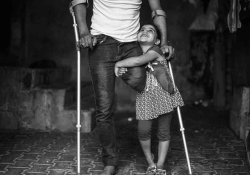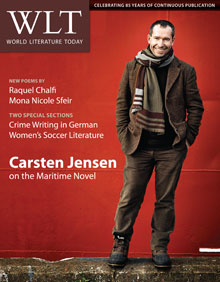EXCERPT: Vi sejlede bare (2009; We just sailed) by Carsten Jensen
The Long Way Home by Carsten Jenson
The following excerpt serves as the introduction to Vi sejlede bare (2009; We just sailed)—Jensen’s elegant book on the making of We, the Drowned—coauthored by Karsten Hermansen, archivist of Denmark’s Marstal Søfartsmuseum (Marstal Maritime Museum). For more about the maritime history of Marstal, visit the museum’swebsite (in Danish), and check out our list of recommended maritime novels.
There are several reasons why I chose to write a novel about the sailors of Marstal.
One reason is entirely banal and obvious. I was born on Ærø, the island on which Marstal is located. I spent half my childhood in the town, far and away the best half, I might add. My father was a sailor just like the sailors in We, the Drowned, and I have always felt a debt of gratitude to the town and its people. How do you pay back such a debt when you are a writer? With your words, of course.
But if my memories had been all that led me to write We, the Drowned, it would have been an autobiography, not a novel.
Another reason is what I would call historical—and possibly a little bit political. If an average, ordinary Dane from a few generations back, in the 1950s, had been asked what sort of country Denmark was, they would have answered without the slightest hesitation that we were a seafaring nation. It wasn’t because more people worked in the merchant fleet of that era, because even back then the number was modest. It was a unique self-image we had as Danes, which also is reflected in, for example, the royal anthem, “King Christian stood by lofty mast.” The Danish path to power and glory lay over the ocean.
Ask the same question today and you will get a completely different answer. The initial response will be obviously correct: we are a welfare state— and if the person being questioned is a bit sophisticated, they will thoughtfully add: a post-industrial welfare state. Should the question be more explicit as to our historical identity, the answer will be dramatically different from the typical Dane’s answer fifty years ago. Modern Danes no longer speak of Denmark as a seafaring nation. We were a nation of farmers, they will say. There is where we come from. There, in the soil, are our roots.
This shift in Danes’ self-perception as a nation has many causes. For a good number of years we have been governed by a party with roots in the farming community. Grundtvigianism has always been the Danes’ preferred ideology; the clergy is becoming increasingly visible in the media. These are all voices belonging to the rural farming culture. When people become obsessed with their ethnic origins, as Danes have in the past several years, our so-called Danishness, it is more natural for them to find answers in plow furrows than at sea, for the sailor gives vague, uncertain answers when it comes to national identity.
We suffer from historical amnesia. I consider it to be a tragic loss of memory, because it takes place at the most inopportune time in our history, the moment when a trend for which we have only a foreign word—globalization—confronts us with the imperative that, like it or not, we must learn to live with this trend and with foreigners.
The farmer was never much good at these things. He barely knew of the foreigners’ existence, keeping instead to his own kind. The sailor sought out the foreign. He might not have embraced it, but he always brought some of it back home with him. Above all he brought back the knowledge that there was more than one way to do things. He not only had a daily view of a broad horizon. He also knew that something lay beyond it, and that it wasn’t necessarily the same as here. The farmer saw no further than the fences of his fields, and it was from a small plot of land that he formed his worldview.
That is why the sailor, in the era of globalization, is a better forefather than the farmer, and that is why it is a tragedy that we have chosen to forget him.
The only place where the traditional view of Denmark as a seafaring nation perseveres is within the royal house. The royal family has a royal yacht. We have never heard anything about a royal plow or a royal tractor. When a Danish king must prove he is fit and able to be the head of the kingdom, he doesn’t go out and plow a straight furrow; he stands at the helm of a ship. King Frederik was a maritime king, and Crown Prince Frederik can also handle himself on a ship’s bridge. Prince Joachim, who was unlucky enough to be born too late, and who therefore doesn’t have to be anything special, has logically enough received an education in agriculture.
But had these really been my main considerations I would have written an alternative history book or a polemic essay. But I didn’t. Instead I wrote a novel.
So there must be another explanation, and there is, too.
Anovel is a game played with reality. It is also a word game. A novel tells the truth with the help of a lie, some wise author once said. As to the question of where We, the Drowned comes from, my answer is: some fantastical words I once heard, which kept growing inside me until, as the acorn becomes an oak tree, one day they became a novel.
I should describe the circumstances in which I heard the words, because the context is an important part of the story. At the time I was seventeen. My family had moved away from Marstal, and I attended gymnasiet, high school, in Ålborg. My father was still a sailor. He had his own ship, the 220-ton freighter Abelone, built in Holland in 1916 and since lengthened. Abelone was still registered in Marstal, and the times had long since left her behind. In those days, around 1970, the freight market for the small craft trade in Scandinavian waters was almost nonexistent. Most freight was transported by big truck-and-trailers on the newly-built motorways, or loaded onto the freight cars of the state railway, DSB.
In the 1960s, Danes had rising expectations for standards of comfort and welfare. The wages my father could pay, and the conditions the crew onboard the M/S Abelone of Marstal had to live under, belonged to another era. The men were lodged in a forecabin, where four bunks were built into the bulkheads. It was dark and damp. The only light came from a petroleum lamp and a drowsy electric bulb (when the generator was running), the only heat from a petroleum stove. The thin cotton mattresses in the cramped bunk spaces lay directly on wooden slats, and in bad weather seawater ran down into the cabin, you stood in ice-cold water up to the ankles when you left your lurching bunk. If you wanted to wash off you did so, regardless of the season, out on deck. Should you need to answer the call of nature, there was a small metal shed at the ship’s stern. The porcelain toilet bowl in the shed had no mechanism for flushing and draining. There was direct access to the sea underneath. During strong winds—not a rare occurrence at sea—the man in need was obliged to remember, unless he had released something extremely heavy and determined to obey the laws of gravity, to move immediately, for the whole thing would shoot up from the toilet bowl in a great belching geyser.
It was difficult for my father to find a crew. Once in a while old retired skippers, nostalgic for the sea, would sail with him. He fished up some shipwrecked characters in the harbor areas. Their work efforts seldom impressed him. Their often strange and distorted views of life, on the other hand, often scared him. And then he had his seventeen-year-old son. I sailed with him during school vacations.
My father and I had a very complicated relationship. My father was militantly anti-intellectual and of the firm belief that all people who didn’t work with their hands were parasites on society. This included such commonly well-respected professions as schoolteachers and librarians, not that he ever came into contact with the latter. I, however, was of the opinion, which I put into practice, that people were equipped with hands because it would be difficult otherwise to turn the pages of a book. I was enlightened and militantly impractical and therefore totally useless onboard a ship, where I never learned one single thing, either.
I pretended that I was useful, and my father pretended that he appreciated it. It was very involved and exhausting, and if it at all reminds me of any well-known literary example, it would be a story from the only publication my father ever opened, the weekly issue of Donald Duck. Big Bad Wolf is a completely normal wolf who appreciates pigs in the form of roast pork. On the other hand, his son, misleadingly named Lil’ Bad Wolf, is an abnormal wolf. He also likes pigs, but as playmates and friends. My father and I were something like that. Everything I liked he despised, and the life he led didn’t interest me. And yet we were bound to each other in a relationship based on mutual loyalty, which led me to sail with him every time he asked me to.
It was on such an occasion that I heard the words that all of this is leading up to. Bunking down in the dark cabin with me was another man, ancient in my eyes, probably around forty. He had started on my father’s deck many years before as a fourteen-year-old. My father had taught him and recognized his talent for the sea. Therefore he encouraged him to see the world, to sail on a long voyage before returning home and educating himself further in navigation school.
In sailor’s jargon, sailing on a long voyage is also called at sejle på varmen, “sailing on the heat.” In other words, sailing in the tropics, where there is a lot of heat, and where it’s hot you get thirsty. My father’s apprentice got thirsty. He got very thirsty. And by the time he had quenched his thirst many years had passed, and all his dreams of returning home and entering navigation school to become an officer or shipmaster had long since disappeared into the bottle. Now he served before the mast again on my father’s ship, the same place he had started as a boy; he had gotten no further.
It was fall vacation, and we arose at six to make ready to sail. I had heard his return in the early morning hours from a tour of the bars, falling more than crawling down the steep ladder into the crew’s cabin. He couldn’t have slept more than a few hours. His swollen face was red, and he had, as he put it, “pain in his hair.” Suddenly, during the difficult work of covering the hatches, he stopped. A cold rain fell steadily from the low, gray October sky. He turned his face to the rain and sighed heavily.
Then, in a deep, prophetic voice, as if he was reading aloud from the Old Testament, he said the following words: “There shall come a day when all the women of the world shall lie in the gutter and scream for cock, and they shall not be given so much as an inch.” (“There shall come a day when all the women in the world will lie in the gutter screaming for dick,” he intoned. “But not an inch shall they get!”)
Good Lord, I thought, when he had finished his curse. Here is a man with a vision!
I hasten to add that it was a vision I didn’t share. I had neither the years nor the experience to understand the bitterness in those words. But I sensed that here was a man who had gotten one too many nos for an answer.
Later on I discovered that this curse wasn’t his brainchild, the product of an early morning hangover. Sailors have been saying it, if not since time immemorial, at least in many a time and place. A Norwegian reader told me that he heard it spoken in Haugesund in 1977. Another version exists, a more precise or, if you will, narrowly-defined version where the rage is directed toward ship-owners. The ship-owners’ wives do the lying in the gutter, while the sailors passing by, riding white horses to boot, refuse them access to their manhood.
I wasn’t thinking of all this, however, when I heard those words. I was simply thinking that it was a fantastic way of speaking. The next thought that came to me was this: one day I would like to write a book where people talk this way.
Thirty-six years later I had written it. At the top of page 659, a person speaks these very words.
It was a long time coming, but at last I got it down.
After I made the decision in 2000 to begin my book, I traveled to Marstal and visited the Maritime Museum, which is more an eccentric popular movement than a normal museum. I spoke of my plans, still very unclear, and asked if the museum could provide help of some sort or other.
Immediately I was taken down to the archives.
I hadn’t been down there long when I realized that I had stumbled onto a gold mine unbeknownst to the world above.
For centuries Marstallers had sailed all the world’s oceans, witnessing or participating in dramatic historical events. Their town had been bombarded by the British during the Napoleonic Wars early in the nineteenth century. Later that century the town’s seamen were blown to bits in the First Schleswig War. Their schooners were sunk in WWI when Germany declared unrestricted submarine warfare, and during WWII almost a hundred of them disappeared into the icy cold North Atlantic, where they had volunteered to sail in the Allied convoys.
There was a treasure of fantastic stories here, life stories and dramatic events. Marstallers had not only journeyed to the most incredible places on earth, they had also been eyewitnesses for the past two centuries to most of the world’s history, in any case the part of it that took place at sea.
I soon picked up on how over the past twenty years the one half of Marstal had been doing little else besides interviewing the other half. It wasn’t because Marstallers are particularly self-centered—or rather, they are that, too—but first and foremost they are proud of, conscious of the exceptional in their own history.
The story of Marstal’s rise and fall is closely bound to the history of sailing vessels. When these ships were in decline, because first the steamer and later the oil- and diesel-driven ships overtook the freight market, Marstal was also singing its swan song. And just as the final survivors of WWI were being interviewed a few decades ago, and as the survivors of WWII are being interviewed today, Marstallers knew there was something important that had to be preserved before it was too late. And so a small people’s army, guided by the Maritime Museum located on Prinsegade, went into the six small skipper homes on Færgestræder and out to Østersøhjemmet, a nursing home, equipped with tape recorders and notebooks.
“Here,” they said, “write down everything you remember from the days of glory. And if you don’t feel like writing then talk to the tape recorder. And if you have diaries and letters lying around, may we have your permission to look at them? But whatever you do, don’t go to your grave before you’ve told your stories one last time.”
And what is this history of Marstal?
It begins five hundred years ago, at about the same time Christopher Columbus discovered America. Back then Marstallers were what historians call strandsiddere, beach squatters, that is, those who were left over when the island’s land was apportioned. They settled on the long, sloping hill leading down to the Baltic Sea, the hill having no agricultural value, and it’s where they still live. Here they followed in Columbus’s footsteps. They not only discovered the ocean, they discovered their America. At sea there were no lords, no fences, no tiny, exhausted plots of land, no social hierarchies calculated to hold them down and squash their imagination and initiative. At sea they had the same boundlessness and freedom as in the future America. Here a cabin boy could become a captain if he wanted to, and if he was a Marstaller, he wanted to.
Marstallers were soon despised by their neighbors for their energy and ruthlessness. The town blossomed in the late 1700s. Then came the fatal war with the British, and Marstal sank into abject poverty, from which the town with its customary determination soon rose again. By their construction of a kilometer-long breakwater, the town provided their harbor protection from the forces of nature. They were denied help from the King. So they did the work themselves. For forty years they worked on the breakwater until finally it stood finished. They were, in a word that sums up their mentality and history, self-made.
They were that, and with the same energy and ruthlessness as always. To furnish the material for the breakwater they demolished the stone dikes around the island, relics from the time of the dukes. They also plundered the island’s Stone Age graves. They had little respect for the past. It was their own future that concerned them, and in the midst of their destitution they laid its foundation.
Almost forty years after beginning work on the breakwater, they did it again. Once more they accomplished the unforeseeable and epochal, and in so doing they helped safeguard their future. This time it was not an enormous, physically demanding, highly visible monument they built. For the most part it wasn’t even visible, and that was the point. They came up with the idea that the town needed a telegraph station. They requested help from the King, a new King this time, but just like the old one he refused. He might be King of Denmark, but Marstal lay beyond the range of his charge. So Marstallers saw to it that a telegraph cable was laid across from Langeland. As I said, they were self-made.
They were the inhabitants of a flyspeck on a tiny, neglected island in a forgotten corner of the Baltic Sea, so tiny, so neglected and forgotten that Germany, at the peace negotiations at the end of the war in 1864, overlooked Ærø, even though the island was historically linked to Schleswig, which was annexed to Germany, and therefore it would have only been natural if Ærø had been included. But the Germans forgot about Ærø, as the Danish king had.
The citizens of Marstal knew one thing: if they had a telegraph station they would no longer be living on the edge of the world. They would be in the middle, and they wouldn’t have to be content with hauling grain around the Baltic or in Scandinavian waters. The world’s markets would be open to them, and Marstal would find a new place, not on the map of Denmark but on the map of the world.
It was during this time that a Denmark traumatized by its monumental defeat at the hands of Germany found a formula for its survival as a nation, in introspection and pious self-adulation. “Outward loss, inward gain.” Marstallers did the opposite. They turned outward. They embraced the entire world at one time. And they also won inwardly, to boot.
Thirty years later there was only one city in Denmark boasting a larger merchant fleet than Marstal: Copenhagen. Denmark was filled with well-established harbor towns, many of them as old as the kingdom itself, all of them much larger than Marstal. But it wasn't Ålborg, Randers, Århus, Nyborg, Korsør, or Svendborg in second place behind the nation’s capital. It was that flyspeck Marstal, which given its population was still a speck, but by all other reckonings had grown into a cosmopolitan city of the world.
Ibegan staying frequently in Marstal, and during my walks around town I made yet another discovery: in Marstal the television wasn’t the only source of entertainment. There was another screen, the living room window, from which one can look outside and see who is walking by. Now where could she be going—and at this time of day? The ferry’s departure from Rudkøbing was another high point of the day, topped in suspense only by the ferry’s arrival.
And now suddenly I was the one departing and arriving. I could feel the inquisitive eyes follow me around the streets. Something had to be done to relieve the tension building inside the Marstallers.
I went to the local library and allied myself with the staff. Together we held a series of meetings with the town’s citizens, where I initiated them into my project. I talked about my plans and ideas and read aloud excerpts from what I already had written. It became a local version of the TV-series Krøniken (The Chronicles), which was running at that time on the national station DR1, the difference being that here it was possible to peek into the writer’s workroom and follow a story that continually shifted form and direction.
I also made it clear that this was a two-way street. Marstallers got something out of all this, and I wanted something in return. At every meeting I had a list of things I wanted to know more about. During breaks I would be invited to someone’s home for coffee. Ensconced on the sofa with coffee and cake, I would be presented with a packet of letters. They might be Grandfather’s love letters to Grandmother, written as a young man in the 1920s while sailing the dangerous Newfoundland route across the North Atlantic. Would I like to read them?
Or an account written by an uncle who sailed during WWII. When he came home he couldn’t sleep at night, and his astute wife therefore suggested he write down his experiences to vent his pent-up emotions. He ended up with eighty typewritten pages, which no one outside the family had ever read. Was this something I was interested in?
Marstallers approached me on the street to ask which families I was writing about. I answered that all the characters in the novel were fictive, and besides, the novel wasn’t a family chronicle. “Well, but anyway,” they objected, and looked at me earnestly. They had a great-grandfather, uncle, or some other member of the family with an incredibly interesting story. They were sure I could find a place for him in my book.
Gradually I got the impression that for some people the book was like a corporation, and you could buy shares of stock in it. I had to explain to the Marstallers that yes, it was their history, but it was my book, and that I was immune to any and every form of bribery.
Acertain group of engaged participants always showed up at the library meetings. Invariably they sat in the back row of the room, their presence never in doubt because of the distinctive sounds they made. They were the senior women of the town, and they knitted, energetically clicking away all evening long. Silence came only when I asked a question. The knitting sank to their laps, all hands were hoisted into the air. They had seen everything, they had heard everything, and they remembered it all. These elderly women were the Marstal equivalent of the Danish Encyclopedia.
I can cite an example of their vast knowledge. There exists a quarterly periodical written for presumably the most unhappy people on earth, natives of Ærø forced to live in exile. The name of the publication, logically enough, is Ærøboen (The Ærø Native). It prints a regular column called From Over There. This column supposedly provides its readers with unbiased information. In reality it is juicy gossip.
In my quest for inspiration I have read every volume from eighty years of this local gossip rag, and in an entry from May 4, 1945, something caught my eye. A woman on Møllergade had been picked up by the authorities; from her balcony, with a loaded gun, she had threatened a street crowd assembled in front of her house.
During a meeting I asked if any of those present could help me with an explanation of the woman’s dramatic behavior.
Immediately silence fell upon the back row, knitting sank onto laps, and every hand shot into the air. The representatives of the Marstallian Encyclopedia knew not only who the woman was. They not only knew her name and age (it was, after all, merely sixty years ago). No, they also knew something even more important to the story. They knew her weight.
As it happened, she weighed a lot. That was one thing about her. Another was that she was very favorably inclined toward men. Many cultures exist where these two things, being fat and man-happy, are a fortunate combination. It just so happens that it wasn’t at this particular time in Marstal, and the woman on Møllergade therefore led an unsatisfactory life until one fine spring day, when literally boatloads of energetic young men arrived on the island, men who weren’t particularly critical about the appearance of the opposite sex as long as they were willing, which the woman on Møllergade was. Five happy years followed for her, years the rest of the Danish population called the five miserable years. It was the Occupation we’re talking about here, the handsome young men were German soldiers. But everything comes to an end, even the best things in life, also for the woman on Møllergade. She did have the foresight to demand a gift from her last lover, a pistol with ammunition and instructions on how to use it.
May 4, 1945, after the message of the Liberation was broadcast over Radio London, the existence became known of a group of men in Marstal who were expert at keeping a secret. Namely, that they were enemies of the Germans. No one else in town had been aware of this, least of all the Germans. When the German army capitulated these men boldly stepped forward to reveal their true Danish faces, before closing ranks and setting out for Møllergade, where justice at last would be served and the enemy is dealt a decisive blow. But the fat woman was ready. She stood on her balcony and aimed her pistol menacingly at them, whereupon they all remembered urgent errands somewhere else in town. From what I have been told, this is how she avoided having her head shaved and being paraded naked through the streets with swastikas painted on her exposed body. And this is how a flock of good Marstal citizens were prevented from proving their courage, which must have been huge since none of it had been used up for five long years.
This episode is, however, not in We, the Drowned. The novel begins in the spring of 1849 and ends at precisely 8:30 p.m., May 4, 1945. The fat lady first waved her gun an hour later, thus missing out.
Often I’m asked what is real and what is fiction in We, the Drowned. In other words: what did I find in the archives and what did I just make up?
Usually I answer that in this case a simple rule of thumb applies. The more unlikely it sounds, the more you can be sure it really happened. The more commonplace and banal it sounds, the more you can be sure I made it up. The reason behind this is what I call the anecdotal structure of autobiographical accounts.
What do I mean by that?
If I ask an old sailor from Marstal to tell me about his life, he will of course begin with his childhood, but all he will talk about are his pranks. His time in school, his relationship with his mother who had to run the household by herself, his usually-absent father and how he missed him—none of this is something he will say much about. But the time he blasted a porcelain insulator off a streetlight pole on Møllevejen with his cousin’s shotgun and the lights went out in half of Marstal—now that he will give a detailed account of. The same pattern emerges when I ask him to tell about his years at sea.
He will remember a shipwreck off the rocky coast of Newfoundland, a torpedo attack or a mine exploding during WWII. His face will light up when he tells about an incredible barroom brawl in Buenos Aires, and should the wife slip into the kitchen for a few minutes to make coffee and prepare the cakes, he will lower his voice and abandon himself to memories of the beautiful women in Mexico’s seaports.
But what about the dreams he had as a young man? Falling in love? How it felt to be a father and yet almost never see his children? What was the loneliness of the long night watches like, the fear when the breakers thundered against the ship?
Not a word.
It’s not because the old skipper is unable to describe his emotions. True, he’s not used to doing so. But that’s not why he remains silent. He simply regards it as unnecessary to talk about them. This is how life is, after all; this is how everyone lives it. Everyone knows about it and therefore there is no reason to waste words telling about it.
That is the essence of what a sailor talks about when he comes home: the unknown, the never-before-seen, the very unusual. He believes that his inner life, or life back home on land, can never be told as a story. He assumes that nobody cares to hear about these things because everybody lives this part of life, everybody knows about it. It’s nothing.
He doesn’t realize that he represents a dying way of life, and therefore everything about his life is interesting. The many volunteers at the Maritime Museum who sought out the old seamen and asked them to confide in the notebook and tape recorder shared his viewpoint. They also wanted to hear of the unusual.
That was the problem I had. I found enough material for ten James Bond novels in the Marstal Maritime Museum’s archives. But the people who experienced all these breakneck adventures, of them I found almost nothing. They hid themselves behind a language often as laconic as that of the Icelandic sagas. Sure, I could write a hair-raising, exciting novel based on these true experiences. But there would be no believable or consistent characters in it, no figure a reader could sympathize with or reject, live and suffer with, reflect over, be astonished at.
It was as if I were about to build a house. Bricks I had enough of. But everything that binds the bricks together, the mortar of a human, the dreams, longings and hopes, courage, stamina, love and friendship, all of that I lacked. I had to find that for myself. This was the challenge to my imagination, not the adventure of a sailor’s life, but the commonness of it, its general humanness, if you will.
What is imagination? An acute awareness of the limits of reality? Exaggerated belief in ones own power to create? Insight into another human being, far inside the doors he or she has closed to others because they lead into much-too-private rooms? Imagination is perhaps all these things rolled into one, with an ever-shifting balance among the many elements of the imaginative force.
I was the one, then, who created the characters in the novel, but often with inspiration from the real Marstal. Some are quite anonymous figures I stumbled onto, was told about over a coffee table or while out on a stroll, just a few words, summing up a life that had taken a strange or tragic turn. Others I found in the archives. A few had left behind extensive written material about the life they led, their thoughts and views.
Probably the most articulate and reflective of all those I came across was the ship-owner Albert E. Boye, who was the inspiration for Albert Madsen. The two share the same attitude toward life. Many of Albert Madsen’s reflections were borrowed from Albert E. Boye. They also share the ship owner’s stately appearance. Even Albert Madsen’s ability to visit foreign locales in dreams, which led many reviewers to detect strains of so-called magic realism in We, the Drowned, comes from the man he was modeled after. The otherwise down-to-earth Albert E. Boye was of the conviction that at night his soul, on its own initiative, undertook expeditions all over the world. But their lives unfolded in completely different ways. Albert Madsen, like all the novel’s characters, is a sort of patchwork creation, his pieces gathered from many places. My imagination is the thread that holds the pieces together.
A person like Herman has never lived in Marstal. This murderer and rapist who yearns so intensely for the town’s acceptance is my creation. The same goes for Marstal’s death angel, Klara Friis, though certain features of her character were borrowed from the town’s history, and even from the neighboring island of Birkholm—she has a lot in common with a young woman who lived there. Klara Friis’s son, Knud Erik, the sailor during WWII who went through so many horrible, traumatic experiences, has the same first name as an old sailor from Marstal, and that is no coincidence; on the contrary, it’s meant as a tribute. Knud Erik Madsen sailed five years in the service of the Allies during WWII, and it was he who made it possible for me to depict the war from the vantage point of a sailor. His temperament and life history is very different from my novel’s character, but they share many experiences. Knud Erik Madsen is also the only one of my character models who got to read the novel. He was ninety-one when We, the Drowned was published in Danish, and his niece read it aloud to him while he sat in his favorite armchair in Østersøhjemmet, Marstal’s nursing home.
One old sailor eighty-three years of age thought he recognized himself in Vilhjelm, the boy who performs acrobatic maneuvers at the top of a schooner’s twenty-five-meter mast. I knew the old man from my childhood, when with the best of intentions he once delivered a stinging slap to my face. He never crossed my mind as I wrote the scene, but I didn’t have the heart to tell him.
He sat for a moment, staring straight ahead. “But it doesn’t make any difference,” he said. “We’re all of us in there, nice-and-quiet-like; we don’t even see it ourselves.”
I was very moved by his words. He had seen into the heart of the novel and understood what I’d wanted to do.
Many people recognized themselves or someone dear to them that way, nice and quiet, in We, the Drowned. There were also some for whom the discovery turned into a dramatic experience. A man my age came up to me at the baggage claim in Kastrup Airport. His father had sailed in convoys during WWII but had refused to talk about his experiences.
“It was first when I read your book that I realized what he had been through.” The man hesitated a moment. Then his face turned red. “I cried for half a day. I just couldn't stop.”
Avery few people have wandered directly from reality into the novel. The sadistic teacher, Isager, is one. Albert E. Boye has drawn a richly-detailed and savage portrait of Isager in his memoir sketches. The teacher’s real name was Ishøj, and by coincidence I happened upon his gravestone in Marstal’s cemetery after I had finished the novel. In an early draft he appeared under his real name. My thinking was that it had been so long ago, no one would be bothered by it, but Marstallers warned me. “His descendents live on Langeland,” they said, “and they’re known to be troublemakers.”
Often I am asked if there really was such a teacher in Marstal. The question is always put to me in imploring tones, as if the questioner needs assurance that such a child-hating, violent person has never been allowed to teach in the Danish schools. I have to tell the truth. During one occasion, after Isager’s existence had been affirmed, a heavy-set man stuck his paw in the air. “We got a real kick out of that portrait of him in our family,” he said, grinning. “He was my wife’s great-great-great-grandfather.”
A few critics have accused We, the Drowned of being an unsubtle tribute to Marstallers, filled with heroicized portraits of the town’s noble citizens. Isager should be enough to contradict this ridiculous assertion. Laurids turns his back on his family and ends up a drunk on a South Sea island. His son, Albert Madsen, has problems controlling his violent tendencies and on one occasion slugs his much younger mistress in the face. Herman is a murderer and a rapist. Knud Erik not only has an alcohol problem. At one point he also shoots a defenseless man, a German pilot kneeling on the wing of his downed airplane, begging for mercy. All of them are Marstallers. No one from Marstal has complained about these portraits or denied that fellow townspeople were capable of acts such as these. They know from their own experience that humans are complex beings with the capacity for both good and evil, and it is such beings they meet again and again in the book.
Ihave seen reality and the novel meet and smelt together in the strangest way, becoming one and the same thing. It happened during a talk at Vanløse Library. During the break, three elderly people approached me bearing an obviously heavy bag. They introduced themselves as siblings, originally from Marstal.
“I’m sure you remember,” one of them said, “at the start of your book, during the English siege of Marstal, you describe how a cannonball falls through the roof of a house on Korsgade 3?”
I nodded. Yes, I remembered that. During my research I had learned that a cannonball in fact had fallen through a roof on Korsgade, and I had used that event to give the birth of Laurids a sense of the extraordinary. When the cannonball crashes through the roof, his mother, in utter shock, gives birth to him on the kitchen floor.
The three siblings set the bag in front of me on the table. One of them, an elderly woman, opened the bag and began rummaging round for something at the bottom. A moment later she held the object out to me.
“Here’s the cannonball,” she said.
On an April day in 1808, over twenty cannonballs landed in Marstal, and I have often speculated about what became of them. I read that a few were used in the kitchen as mortars, to grind mustard seed for the mustard sauce that was an important part of Marstallers’ favorite recipe for cod. It never crossed my mind that one of the cannonballs still existed, and that it had been passed down from generation to generation and now, two centuries later, was still a living memory of that day when the bombs fell on Marstal.
They let me hold the cannonball in my hands. It was rusty, small, compact and very, very heavy. It was an extremely strange and moving moment.
I experienced this amalgamation of reality and novel again in a very different and surprising manner. In the period after the novel was published, Marstallers occasionally approached me on the street, and several of them made the same remark. “Of course I heard all of these stories when I was a kid.”
I gawked at them. They couldn’t have heard the stories when they were kids. I had made them up.
But a shift had taken place in the town’s memory. What Marstallers had recently read got mixed in with old words once heard, the tall tales from childhood and the stories from the novel flowed into each other and became indistinguishable. I’m sure that historians of the future will curse my name, for I have done everything I could to destroy the foundation for their work.
I’ve stated that as a rule of thumb, the more unlikely something sounds, the more the reader can be certain that it actually happened. Are there no exceptions whatsoever to this rule?
There really was a sailor at the battle at Eckernförde Fjord who, when the Christian VIII exploded, soared high up in the air and landed on deck and survived, exactly as Laurids did. There was also a galley boy who, when one of the munition ships in a WWII convoy exploded into bits, was fished out of the sea eight hundred meters away, still alive.
After one of my talks a charming lady came up to ask a question, obviously in hopes that she could keep the answer to herself, as if it were a secret we two would share. “Where is it in Marstal I can go to see James Cook’s head?” she asked, whispering confidentially.
“Nowhere,” I answered, and tapped my head. “The only place it exists is up here.”
Here is the exception. That James Cook’s head should have ended up in Marstal is not only unlikely. It’s also a lie.
The idea of placing the head in the novel came from reading the young Mark Twain’s accounts of his travels in Hawaii, which in his time was called The Sandwich Islands. He gives a surprisingly irreverent and ironic account of the English explorer’s exit. Obviously Mark Twain didn’t think particularly highly of James Cook, and he appears therefore to have been amused at the fate of Cook’s various body parts after being murdered by agitated natives. Cook’s intestines, grilled over an open fire, were dispatched by a flock of kids who thought they were from a dog.
After reading this I began thinking about what could have happened to one very important body part, namely, James Cook’s head. No first-hand accounts of its fate exists, and consequently it came to me that I could solve the mystery of the famous explorer’s missing head. This is my chance, I thought, to inscribe my name in world literature. In all modesty, I do believe it was an inspired idea to let James Cook’s head end up in Marstal, but historically, the idea is flawed in every way. The Hawaiian natives were technically unable to shrink heads, and though headhunters did exist in and around the Pacific Ocean, the only ones to hit on the idea of skinning the heads of enemies and smoking the skin over a fire were some tribes in the Amazon jungle.
If that charming lady had asked her question a year later I could have given her a completely different answer. The eccentric Maritime Museum of Marstal borrowed a shrunken head from a collector on the island and exhibited it in a glass case, boldly claiming that this was the very head one could read about in my novel.
One episode in the novel makes certain readers shake their heads in resignation. It takes place in the final section, during the passage of a convoy through the North Atlantic. Knud Erik, the captain of the Nimbus, jumps desperately into the ocean to save a drowning sailor, the last survivor of a torpedoed ship. When he grabs hold of the sailor he discovers that it not only is a woman, but what’s more a pregnant woman, who has just had her baby underwater.
Did this really happen? Is it even possible?
It wasn’t long after the novel came out that a friend of mine, a midwife by profession, brought to my attention that giving birth in an ice-cold ocean, only minutes after so violent an event as a torpedo ramming a ship, was impossible, even if the birth had already begun before the torpedo hit.
“The experience would simply be so traumatic that the birth would stall,” she said, with the irrefutable authority of one who had helped bring hundreds of babies into the world. Or to put it another way, the baby would obviously reason that if this was what the world was like, it wanted no part of it.
When I am out giving a talk about We, The Drowned, I always know if a midwife is in the audience. Whenever someone asks a question about the dramatic underwater birth, that someone is a midwife.
There was one occasion when a man asked about the underwater birth, but only to gripe about the book being “too far out.” Calmly I countered that already on page one, when Laurids sees St. Peter’s ass, the message is being sent that the whole novel is too far out, so it couldn’t come as a surprise to him. Then I added more forcefully that maybe it’s true that I had disobeyed the laws of nature in this scene, but I didn’t give a shit.
It was a female reader who, during the question-and-answer period after one of my talks, spoke the words I’d been waiting to hear. “I don’t care if it could really have happened or not. By the time I reached that place in the novel I just felt so miserable. It was nothing but death and destruction, it was all so totally hopeless, and then in the middle of this apocalypse a baby came into the world, and suddenly there was hope again.”
I told her that the writer had felt exactly the same way as he wrote the scene, and that was why I had written it.
One person kept showing up long after the publication of We, The Drowned: my father. He may have been dead, but when I was out talking about my book I was constantly reminded of him.
I never got to tell my father about my plans for the book. I told the people of Marstal, and yet he was completely in the dark, though it was his world I wanted to depict. A peculiar form of unease held me back, as if I was about to trespass on his property. Without realizing it myself, the book was meant as a final attempt to bridge the gap between our differences, which had always existed. I had learned to live with them, true enough, but I had reached the age when you understand that you always owe your parents something, regardless of how different your life has been from theirs. First and foremost, my father was a great storyteller, every bit as liberal with colorful detail as he was with the truth when he told of his life at sea that, at the time he retired, had stretched over half a century. Now I wanted him to tell these stories again, stories which had helped keep a window open in a childhood that otherwise could feel cramped and closed in.
For the first time in many years I had visited Marstal, and from there I set out for Tåsinge, where my mother and father spent their last years together. But my father had suddenly taken ill. He became introverted and remote. A short while later he died without knowing of my plans for a book about the lives of sailors.
My father’s death became the starting point of my work on the book, but I quickly realized that he would not be in it. I laid down a simple rule for what became a novel and not a memoir: the book must not contain any personal experience, which would limit its scope and chain me to my family’s history.
But there my father was again.
He was there in the figures of old sailors and skippers who walked up to me after my talks. They had all known him, several of them had sailed with him. They sighed sadly, as if they were speaking at his funeral, and they all said the same thing: “Your father and I, we drank a damned lot of beers together.”
I heard the sentence so often, and formulated in such an identical way, that soon I began to feel they should have been the words carved on his gravestone, if he had had one. He didn’t want one. Instead he was cremated and his ashes placed in an urn that was sunk in Svendborg Sound near the old skippers’ houses in Tåsinge. He ended up in the sea he had spent so many years on and which could just as well have swallowed him in a shipwreck long ago.
There was one thing the old sailors and skippers didn’t say. But I could hear it in their voices and see it in their eyes. In writing We, The Drowned I had given my father the gravestone he hadn’t wanted. I had also given them a monument, for they all felt themselves to be part of a fellowship whose merciless conditions were dictated by the ocean.
One summer day at the beach, several years before I finished We, The Drowned, I had a serious conversation with my cousin. She is several years older than me, and despite my having reached a certain age she was still capable of being maternally concerned about my future.
“Dear cousin,” she said to me. “I’m so worried about you. I see how hard you work on your book. But do you really believe that anyone not from the island will be interested?”
It took me a long time to answer, and when I finally did it was nothing more than an empty inanity, that I really hoped so. Of course I wanted many people to read it. But my cousin had hit a sore spot, for obviously I could be certain of nothing. The more I thought about my cousin’s question, the more I realized that the answer involved not only the difficult question of the novel’s essence, but also of who a novel’s readers really are.
Journalists for dailies, for example, know who their readers are. Past readership surveys have charted out which social groups the newspapers target. For journalists who aren’t aware of their readers’ prejudices and preferences, letters to the editor and a few too many invitations to visit the editor-in-chief’s office will quickly educate them. The situation is more of a mystery for authors. They seldom know who reads their books, although it’s probably not wrong to assume that the majority of their readers come from society’s bedrock of culture, well-educated women over forty.
Many years ago, in my book Confessions of an Asthmatic Critic, I tried to find an answer. The citizen of that blacked-out land where the author of fiction sends his works out to, I called “the unknown friend,” a term which refers primarily to the tone in which a book is written: as if to a peer, playfully or seriously, but always with an undercurrent of a commitment to truth, as friends talking to each other.
But who, or rather, what is a reader?
Concerning this question, I oppose every attempt at a psychological or sociological reduction of readers. I consider the sociological classification of people into so-called segments, that is, social groups with their own predictable and coherent patterns of behavior, as a totally destructive mode of thought when it comes to understanding or explaining anything, except for how a business can easily sell its superfluous products or a politician his hackneyed clichés. It is a form of tribal mentality from which we would distance ourselves if the label “ethnic” were attached, but because modern sociology rubber-stamps it, and because it has proved useful in marketing analysis, we accept it, though it is every bit as repulsive as ethnic or nationalistic modes of thought in its reduction of human complexity to the one-dimensional predictability of group identity.
With my manuscript in hand a sociologist or market analyst would have asked: Who is your target group? People with connections to Marstal and Ærø? Sailors and their families? Elderly pipe-smoking men partial to sea battles? Uncles impossible to find Christmas presents for?
I would have shook my head no to every question, until finally the market analyst would have thrown up his arms and declared that he whole-heartedly shared my cousin’s concern.
In the meantime I would have recalled a conversation I once had with a close friend, whose new novel I had read and in careful but unmistakable terms criticized, which is always a delicate balancing act, even in the most seasoned of friendships. A long pause followed, during which he considered what I had said. Then he spoke, his tone of voice revealing that he didn’t want to discuss my criticism: “I think your problem is, the subject doesn’t interest you.”
I have read books about masturbating college boys in the U.S., about kite runners in Kabul, about a physician in ordinary to the Danish Court, about musicians on the Titanic, about exceedingly hairy women in Norwegian provinces, about the absurdities of the Austro-Hungarian judicial system, about hunting whales in the Pacific, about adolescent criminals in czarist Russia, and not one of them I read because the subject interested me. In every single case it was because the novel was great literature that rose above the time and place in which it was written, and appealed to something in me that also was beyond time and place.
That is the answer to my cousin’s question: I wrote not only for Marstallers, or sailors and their families, for the men who love the salt water or the impossible uncles. Nor did I write for the reader inside myself. I wrote in the belief that there is something sociologically indefinable in people that binds us all together, and which is the impetus both when we read and when we create, an urge to explore a vast inner continent, and it was for the inhabitants of this continent I wrote.
That is the writer’s secret utopia: to write for everyone, whether man or woman, old or young, sailor or staff employee, whether they have had seven or twenty years of schooling, are Danes, Norwegians, Germans, Polish, Spaniards, English, Indian, Chinese, or American.
And maybe even to write for a father who is militantly anti-intellectual and detests books and their authors.
There is something that sailors and authors have in common: they dream of traveling everywhere, the sailor on his ship, the writer with his words.
That is the unspoken premise for everything an author writes: that we humans, despite the differences in our appearance, all have something in common, and that this commonality is not what the market analyst and the television executive so disgracefully call “the lowest common denominator,” but the very highest in us all, and that is what unites us and keeps our curiosity alive.
Translation from the Danish
By Mark Kline
Editorial note: From Vi sejlede bare, copyright © 2009 by Carsten Jensen & Karsten Hermansen. English-translation copyright © 2011 by Mark Kline. Reprinted by arrangement with the Marstal Søfartsmuseum and Houghton Mifflin Harcourt.










